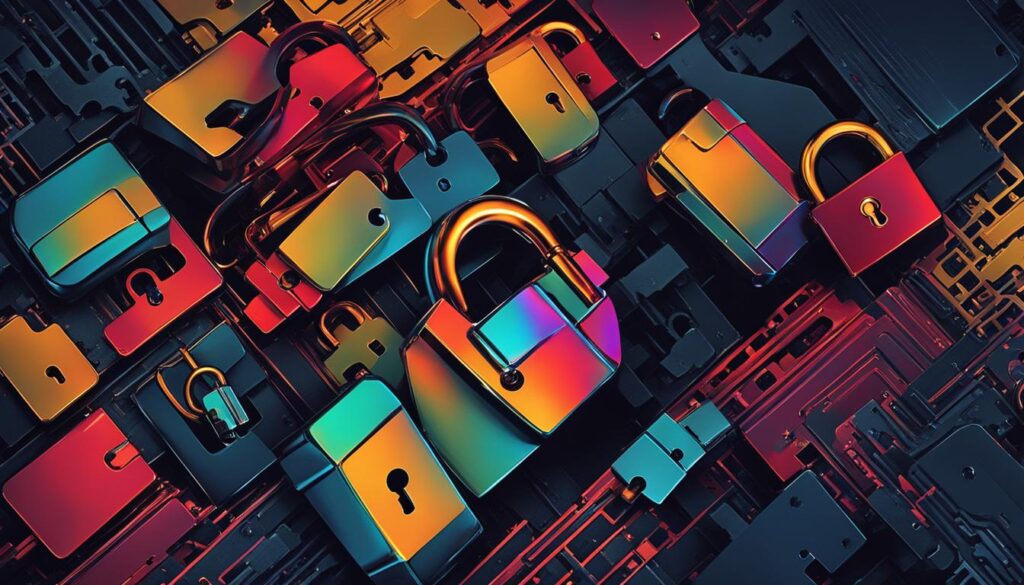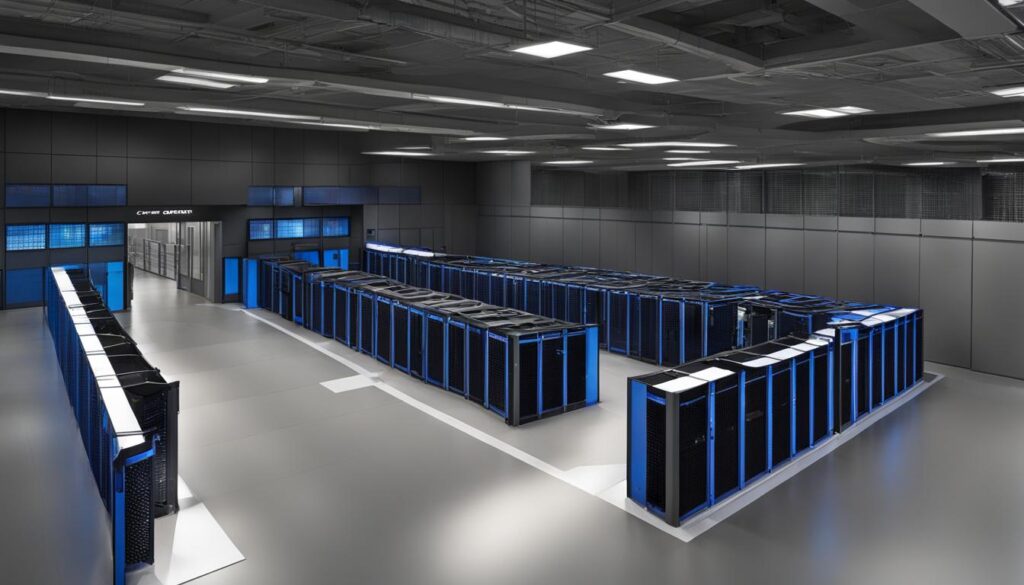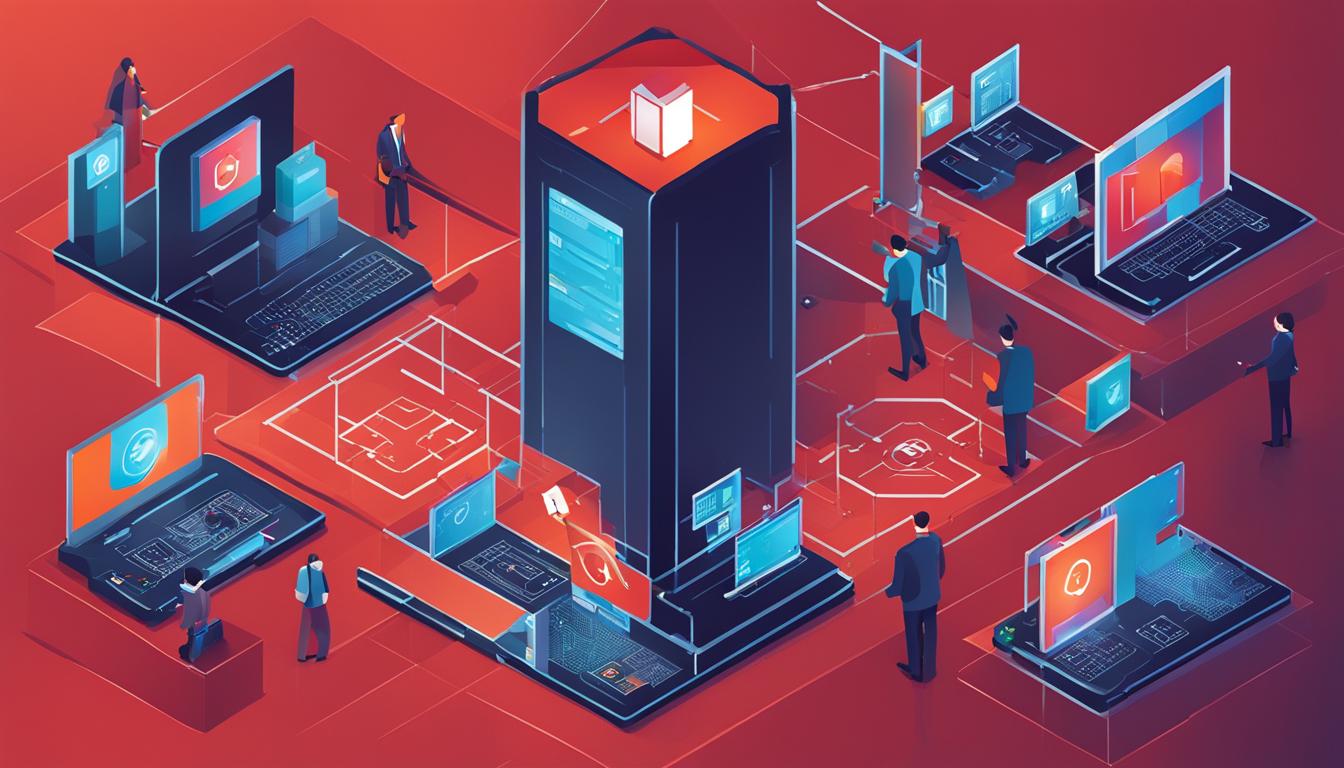Welcome to our comprehensive guide on IT security controls. In today’s interconnected world, where data breaches and cyber threats are becoming increasingly prevalent, implementing effective security controls is more important than ever. In this article, we will delve into the world of security controls in information technology, discussing what they are and the different types that exist.
Contents
- 1 What Is a Security Control?
- 2 Goals of Security Controls
- 3 Technical Security Controls
- 4 Administrative Security Controls
- 5 Physical Security Controls
- 6 Conclusion
- 7 FAQ
- 7.1 What are security controls in information technology?
- 7.2 What is a security control?
- 7.3 What are the goals of security controls?
- 7.4 What are cyber risks and threats?
- 7.5 What are technical security controls?
- 7.6 What are administrative security controls?
- 7.7 What are physical security controls?
- 7.8 What are the best practices for effective security controls?
- 8 Source Links
Key Takeaways:
- Security controls are essential measures in IT that protect data and infrastructure from security risks and threats.
- There are three main types of security controls: technical, administrative, and physical.
- Technical controls utilize technology to reduce vulnerabilities, administrative controls involve policies and guidelines, and physical controls focus on protecting physical assets.
- Implementing a combination of security controls is crucial for comprehensive risk mitigation.
- Adhering to security control frameworks and performing regular assessments are best practices for maintaining an effective security posture.
What Is a Security Control?
A security control is a countermeasure or safeguard implemented to reduce the likelihood of a threat exploiting a vulnerability. Its main purpose is to mitigate risk by reducing the chances of an incident occurring. Security controls aim to protect the confidentiality, integrity, and availability of information by addressing vulnerabilities and preventing security incidents.
Implementing different types of security controls is crucial for effective risk mitigation. The choice of security controls depends on the goal of the countermeasure, the level of risk, and the severity of potential damage.
By implementing security controls, organizations can:
- Mitigate Risk: Security controls help reduce the likelihood of security incidents and the potential impact of vulnerabilities.
- Address Vulnerabilities: By identifying and addressing vulnerabilities, security controls strengthen the organization’s defense against threats.
- Protect Confidentiality, Integrity, and Availability: Security controls play a crucial role in safeguarding sensitive information and ensuring its accessibility and reliability.
Overall, security controls provide the necessary framework to protect organizations from potential security breaches and ensure the smooth operation of their IT infrastructure.
Goals of Security Controls
The primary goal of security controls is to reduce the impact of security incidents and prevent them from occurring. To achieve these goals, different types of security controls are implemented based on their specific objectives:
- Preventive Controls: These controls are designed to proactively prevent security incidents from happening in the first place. They focus on eliminating vulnerabilities and minimizing the risk of exploitation. Examples include:
- Implementing strong access controls and authentication mechanisms
- Using encryption to protect sensitive data
- Regularly updating and patching software to address known vulnerabilities
- Implementing intrusion detection systems and security monitoring tools
- Performing regular security audits and assessments
- Monitoring network traffic for suspicious activities
- Recovering from backups to restore data and systems
- Implementing incident response procedures to contain and mitigate the incident
- Conducting forensic investigations to identify the root cause of the incident
- Displaying warning signs and notices indicating the presence of security measures
- Implementing strong physical access controls, such as security guards and surveillance cameras
- Enforcing strict security policies and disciplinary actions for policy violations
- Implementing additional monitoring and auditing processes
- Introducing redundancy and failover mechanisms
- Using alternative security solutions when primary solutions are not available
These goals guide organizations in the implementation and management of security controls, ensuring comprehensive risk mitigation and protection of information assets.

Technical Security Controls
When it comes to safeguarding your IT systems and protecting against cyber threats, technical security controls play a vital role. These controls, also known as logic controls, employ technology to reduce vulnerabilities in both hardware and software.
Here are some key technical security controls that you should consider implementing:
- Encryption: One of the most effective ways to protect your data is through encryption. By encoding your data, encryption ensures its confidentiality and prevents unauthorized access. It is achieved by using cryptographic algorithms to transform the data into an unreadable format, which can only be decrypted with the proper encryption key.
- Antivirus Software: Malicious software, such as viruses, worms, and trojans, pose a significant threat to your IT infrastructure. Antivirus software helps detect, remove, and prevent the spread of these malicious programs. It scans files and processes in real-time, identifies potential threats, and takes appropriate actions to neutralize them.
- Firewalls: Firewalls act as a barrier between your internal network and external networks, such as the internet. They monitor and control incoming and outgoing network traffic, allowing authorized traffic to pass through while blocking unauthorized attempts to access your systems. Firewalls help prevent unauthorized access and protect your network from various cyber threats.
By implementing these technical security controls, you can significantly enhance the security of your IT systems and mitigate the risk of cyber attacks.
Remember, protecting your digital assets is an ongoing process that requires regular updates and maintenance of your security controls.
Administrative Security Controls
In any organization, security policies, management controls, and operational controls are essential components of efficient administrative security controls. These controls are designed to establish and enforce policies, procedures, and guidelines that align with an organization’s security goals, thereby ensuring the integrity, confidentiality, and availability of information. By implementing effective administrative controls, organizations can effectively manage their security risks and maintain compliance with industry regulations.
One important aspect of administrative security controls is the establishment of comprehensive security policies. These policies serve as the foundation for defining and communicating security expectations, roles, and responsibilities throughout the organization. They guide employees’ actions, outlining the acceptable use of IT resources, confidentiality requirements, incident response procedures, and many other critical aspects of information security.
Management controls play a vital role in the implementation and oversight of administrative security controls. This includes the allocation of resources, appointment of security personnel, and monitoring of compliance with security policies. Management controls ensure that the necessary steps are taken to address security risks and strengthen the overall security posture of the organization.
Operational controls are another crucial component of administrative security controls. These controls involve putting security policies into action through various means such as training programs, access controls, and incident response plans. For example, organizations may provide employees with regular phishing awareness training to mitigate the risk of social engineering attacks. This proactive approach helps to create a security-conscious workforce and reduces the likelihood of security incidents caused by human error.
“The security of an organization heavily depends on the effectiveness of its administrative security controls. By properly implementing security policies and utilizing management and operational controls, organizations can significantly reduce the risk of security breaches and protect their valuable assets.”
It is worth noting that administrative security controls are not solely focused on preventing security incidents, but also on maintaining compliance with industry regulations and standards. Organizations that deal with sensitive information may have legal obligations to protect the data they handle, and administrative controls can help ensure that these requirements are met.
Overall, administrative security controls play a critical role in establishing a robust and well-rounded security framework within an organization. By implementing and enforcing security policies, utilizing management controls, and carrying out operational controls, organizations can effectively safeguard their digital assets and protect against potential security threats.
Key Components of Administrative Security Controls
| Component | Description |
|---|---|
| Security Policies | Establish guidelines and procedures for information security. |
| Management Controls | Allocate resources, appoint security personnel, and monitor compliance with security policies. |
| Operational Controls | Implement security policies through training programs, access controls, and incident response plans. |
Note: The table above provides a summary of key components of administrative security controls. It showcases the essential elements that contribute to a comprehensive security framework.

Physical Security Controls
Physical security controls are critical for protecting sensitive material and safeguarding physical infrastructure, including data centers and other vital facilities. These controls are designed to prevent unauthorized access and ensure the integrity and security of physical assets. By implementing a combination of physical barriers, surveillance cameras, alarm systems, and access control technologies, organizations can establish robust physical security measures.
Physical barriers such as fences and locked doors act as the first line of defense, restricting access to authorized personnel only. These barriers create a physical boundary that deters potential intruders and provides a layer of protection for the data center or facility.
Surveillance cameras play a crucial role in monitoring and recording activities within and around the premises. They enable real-time monitoring and provide valuable evidence in the event of a security incident. Surveillance cameras act as a deterrent, discouraging unauthorized individuals from attempting to breach the physical security controls.
Alarm systems, including motion or thermal alarms, can detect and alert security personnel to any unusual movements or environmental changes. These systems help mitigate the risk of physical breaches by providing early detection and enabling swift response to potential threats.
Access control systems, such as biometric scanners or security card readers, further enhance physical security by ensuring that only authorized individuals can enter restricted areas. These systems provide an additional layer of authentication and accountability, reducing the risk of unauthorized access and potential security breaches.
| Physical Security Controls | Description |
|---|---|
| Physical barriers (fences, locked doors) | Restrict access to authorized individuals and deter potential intruders. |
| Surveillance cameras | Monitor and record activities within and around the premises, acting as a deterrent and providing evidence. |
| Alarm systems (motion or thermal) | Detect and alert security personnel to unusual movements or environmental changes. |
| Access control systems (biometric scanners, security cards) | Ensure only authorized individuals can enter restricted areas, providing an additional layer of authentication. |
Implementing robust physical security controls is crucial for safeguarding data center security and protecting critical infrastructure. By combining physical barriers, surveillance cameras, alarm systems, and access control technologies, organizations can establish a comprehensive physical security strategy that mitigates the risk of unauthorized access and potential security incidents.

Conclusion
Implementing effective security controls is crucial for protecting your digital assets and maintaining data integrity. By following best practices and leveraging security control frameworks, you can enhance your organization’s security posture and mitigate potential security incidents.
One of the key best practices for security controls is to implement a defense-in-depth strategy. This involves layering multiple controls across different levels of your organization’s infrastructure and systems. By employing a variety of security measures, you create multiple barriers that an attacker must overcome, reducing the risk of a successful breach.
Adhering to recognized security control frameworks, such as the NIST Cyber Security Framework and the Center for Internet Security controls, can provide you with a comprehensive set of guidelines and controls that are aligned with industry standards. These frameworks offer a structured approach to implementing security controls and can help you prioritize your efforts.
Finally, performing regular security control assessments is essential to ensure the effectiveness of your controls. By conducting regular evaluations, you can identify any gaps or weaknesses in your security measures and address them promptly. This proactive approach allows you to stay ahead of emerging threats and adapt your security controls accordingly.
FAQ
What are security controls in information technology?
Security controls are essential measures implemented in information technology to protect data and infrastructure from security risks and threats.
What is a security control?
A security control is a countermeasure or safeguard implemented to reduce the likelihood of a threat exploiting a vulnerability. Its main purpose is to mitigate risk by reducing the chances of an incident occurring.
What are the goals of security controls?
The goals of security controls include prevention, detection, correction, deterrence, and the use of compensating measures. These goals guide the implementation and management of security controls to ensure effective risk mitigation.
What are cyber risks and threats?
Risks refer to the likelihood of a threat exploiting a vulnerability, which can result in various losses. Threats can come from external sources connected to the internet or from insiders within an organization. Vulnerabilities are weaknesses or flaws that can be exploited, leading to security incidents.
What are technical security controls?
Technical controls, also known as logic controls, utilize technology to reduce vulnerabilities in hardware and software. These controls include measures such as encryption, antivirus software, and firewalls.
What are administrative security controls?
Administrative controls refer to policies, procedures, and guidelines that define personnel or business practices in line with an organization’s security goals. These controls are enforced through security policies and implemented by management and operational controls.
What are physical security controls?
Physical controls are measures implemented to prevent unauthorized access to sensitive material and protect physical infrastructure. These controls can include physical barriers, surveillance cameras, motion or thermal alarm systems, and access control systems.
What are the best practices for effective security controls?
Best practices for security controls include implementing a defense-in-depth strategy, adhering to security control frameworks, and performing regular security control assessments. These practices can enhance an organization’s security posture and mitigate potential security incidents.




